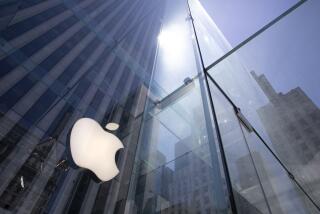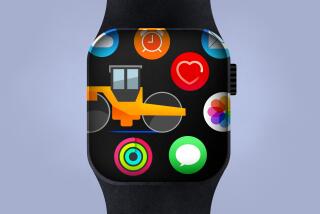Pressure builds for Apple to overhaul or expand product portfolio
- Share via
Apple iTV? The iWatch? Bigger iPhones and iPads?
Rumormongering about such mythical products is a regular spectator sport for many Apple watchers.
But after the company said it could post a year-over-year decline in revenue this fiscal year for the first time since 2002, such conjecturing is turning into high-octane pressure for the company to do something, anything, to reboot growth.
“Apple needs to have more products it can sell into its high-priced customer base,” said Colin Gillis, an analyst at BGC Partners. “You should have a degree of urgency here.”
Concerns about the weak outlook for iPhone growth sent Apple’s stock plunging Tuesday — it fell $44, or 8%, to $506.50 — a day after the company reported disappointing fiscal first-quarter earnings. Apple sold 51 million iPhones over the holiday quarter, a record, but also less than the 55 million units analysts had predicted.
More ominous for many investors, though, was a lower-than-expected projection for revenue in the current quarter. Though Apple said there were technical reasons behind its guidance, such as changes in inventory and accounting for revenue, analysts had still assumed that a deal to sell the iPhone through China Mobile, the world’s largest carrier, would give Apple a boost.
Instead, analysts wondered whether the disappointing outlook was part of a broader signal that the smartphone market, especially the high end that Apple dominates, is becoming saturated. Indeed, rival Samsung also recently reported disappointing sales and Verizon Wireless also said smartphone activations were slowing.
“Apple is fighting an uphill battle in this market,” said Brian White, an analyst at Cantor Fitzgerald. “The smartphone market overall is having problems.”
Considering that Apple still makes most of its profits and revenue from the iPhone, the potential for such a slowdown is troubling. As a result, analysts increasingly believe that a dramatic overhaul of existing products, or entering a new product category, is essential if Apple wants to keep growing.
Apple remains mum as always on the subject of new products. On a conference call Monday, analysts asked only timidly about the topic, knowing that it was futile to expect a comment from Apple management.
“I would just say innovation is deeply embedded in everybody here, and there’s still so much of the world that is full of very complex products,” Apple Chief Executive Tim Cook said in response to one such query. “We have zero issue coming up with things we want to do that we think we can disrupt in a major way. The challenge is always to focus and to do the very few that deserve all of our energy.”
But those remarks did nothing to dampen speculation. One option for Apple may be to adjust the size of its iPhones.
Rumors have Apple working on an iPhone with screens as big as 4.7 inches, and possibly an iPhone/iPad hybrid (dubbed awkwardly a “phablet”) with a 5.7-inch screen. Either gadget would be bigger than the current 4-inch screen on the iPhone 5s and 5c, and a nod toward the growing popularity of larger smartphones around the world.
“Arguably, they need bigger screens,” Gillis said. “The market wants bigger screens.”
Such gadgets may even debut as early as late spring or summer, according to some reports. Of course, runaway rumors last year that Apple was working on a cheap iPhone turned out wrong.
Talk of an iWatch has cooled after running hot much of last year, though many observers believe it’s natural for Apple to get into the wearables business as a way to extend its ecosystem of products.
But following the earnings release Monday, signals of an update to the Apple TV digital receiver seemed to get louder when the company refreshed its online store to include the gadget as a stand-alone category for the first time. That places it alongside the iPhone, iPad, Macs and the iPod in prominence.
Although the prospect of Apple building a full-fledged TV still seems faraway, there is chatter that Apple may allow developers to start writing apps and games for the $99 set-top box that plugs into a television and enables users to access iTunes content. Over the last year, Apple has dramatically expanded the number of partners offering content through Apple TV.
Also gaining traction is the belief that Apple is working on some kind of digital wallet or payment system. This month, the U.S. Patent and Trademark Office published a patent by Apple for a system of making secure payments through mobile devices.
Part of the thinking is that the new fingerprint sensor that debuted on the iPhone 5s last year, known as Touch ID, will be a gateway for letting users make fast, secure purchases just by touching their iPhone.
“The mobile payments area in general is one that we have been intrigued with and that was one of the thoughts behind Touch ID,” Cook said on the conference call. “You can tell by looking at the demographics of our customers and the amount of commerce that goes through iOS devices versus the competition that it’s a big opportunity on the platform.”
In the meantime, the falling stock price inspired activist investor Carl Icahn to buy an additional $500 million in Apple stock. Icahn, who previously said he owned $3.6 billion in Apple shares, has been pressing the company to use more of its cash to buy back shares to give the stock price a boost.
Apple has said it’s reviewing such options, but also needs enough cash on hand to remain flexible and invest in new products and acquisitions. Icahn said the company has plenty of money to do both. Apple’s cash on hand grew to $158.8 billion in the most recent quarter, up from $146.76 billion the previous quarter.
“We completely agree that the company must innovate and should be flexible to make prudent strategic acquisitions, yet even after taking such factors into account, we believe that tremendous excess liquidity remains,” Icahn wrote in a letter to Apple shareholders last week.
Twitter: @obrien
More to Read
Inside the business of entertainment
The Wide Shot brings you news, analysis and insights on everything from streaming wars to production — and what it all means for the future.
You may occasionally receive promotional content from the Los Angeles Times.











